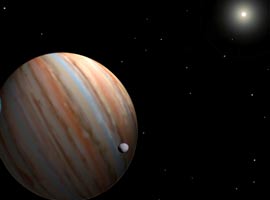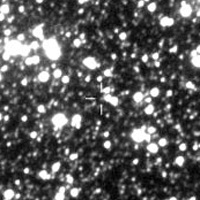
Artist David A. Aguilar depicts the exoplanet that professional and amateur astronomers discovered recently by gravitational microlensing. The planet is about 3 times as massive as Jupiter, and it orbits its host star (upper right) at about 3 astronomical units. The moon is hypothetical.
Courtesy David A. Aguilar (CfA).
In a milestone event, amateur astronomers have participated directly in the discovery of an extrasolar planet last month. The amateurs, who hail from New Zealand, made crucial observations that helped several international collaborations of professional astronomers nail down the existence of the planet. Amateur astronomers have previously detected the presence of exoplanets, but only after professionals made the initial findings.
The newly discovered planet is just the second one found by gravitational microlensing, an effect predicted by Einstein's general theory of relativity. According to relativity, if a massive object such as a star moves directly between Earth and a background star, the intervening star's gravity acts like a lens. It temporarily magnifies the background star, causing a characteristic brightening pattern that astronomers can distinguish from normal variable stars. If a planet orbiting the lensing star comes near the light path, it will either increase or decrease the brightening depending on the geometry of the alignment.

An international pro-am collaboration discovered a planet by observing this faint star in Sagittarius (marked by crosshairs). The star brightened as the exoplanet's host star crossed in front and magnified its light in a process known as gravitational microlensing.
Courtesy Optical Gravitational Lensing Experiment.
While the theory of microlensing is well understood, catching actual events is fiendishly difficult. Several international collaborations monitor millions of faint stars around the clock to catch these rare events. A collaboration known as the Optical Gravitational Lensing Experiment (OGLE), headed by Andrzej Udalski (Warsaw University, Poland), first detected the microlensing event earlier this year. On April 18th, as the event was still in progress, Andrew Gould (Ohio State University) noticed something unusual going on that might involve a planet. He quickly alerted several other groups to monitor the star, including members of the Microlensing Follow-Up Network, or MicroFUN, for short.
Two New Zealand amateur astronomers in this group, Grant W. Christie of Auckland and Jennie McCormick of Pakuranga, caught the microlensing event (designated OGLE-2005-BLG-071) in progress with their 14- and 10-inch telescopes. Their data, combined with those of the professional groups, confirmed a half-magnitude dimming of the background star caused by the gravity of a planetary-mass object. "The amateur data was essential to understanding what was going on," says team member B. Scott Gaudi (Harvard-Smithsonian Center for Astrophysics), whose calculations showed that the deviation was due to a planet.

This light curve, whose data come from five groups, shows how the brightness of the faint background star rose and fell over several months. The sharp rise and fall in mid and late April is due to a planet. If the planet had not been there, the light curve would have followed the rounded dotted line. Click on the image to see a larger version. The observations from Farm Cove and Auckland were made by amateur astronomers.
Source: B. Scott Gaudi (CfA) and Subo Dong (Ohio State University).
The planet acted like an astigmatism in a lens. Its gravity caused the slight dimming because it took a little bit of light that the lensing star was trying to direct toward Earth and deflected it out of our line of sight.
The downside of the microlensing technique is that it yields very little information about the exoplanet or its host star, and no opportunity for follow-up studies of the planet itself. All the discoverers can say about the planet is that it's roughly three times the mass of Jupiter and orbits its unnamed host star at approximately three times the average Earth-Sun distance. The planet and star lie about 15,000 light-years away in the direction of the galactic center.
But microlensing has a huge potential up-side: it can detect the presence of Earth-mass planets using ground-based telescopes and current technology. "This discovery is the tip of the iceberg for microlensing searches. With improving technologies and techniques, the first Earth-size planet may be found by microlensing," says Gaudi.
"If an Earth-mass planet were in the same position [as the exoplanet we found], we would have been able to detect it," adds Gould.

This diagram shows the geometry on the plane of the sky of the foreground lensing host star and planet and the background star, which is the source of the light monitored by the various collaborations.
Source: B. Scott Gaudi and Subo Dong.
Amateurs will participate in future discoveries as well. "These amateur astronomers work all day, then go home and observe all night," says Gaudi. "Their contribution is a testament to how far amateurs have come. It speaks highly of their dedication to the field. If we can get others involved, that would be fantastic."
Christie's and McCormick's names appear on the discovery paper, which has been submitted to the prestigious Astrophysical Journal Letters. The MOA, PLANET, and RoboNET collaborations also participated in the planet's discovery.
 0
0
Comments
You must be logged in to post a comment.